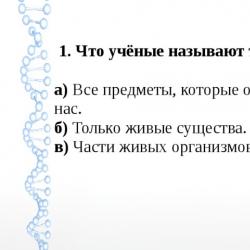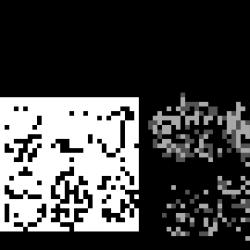Individual development of organisms. Periods of ontogenesis. Individual human development Ontogenesis represents individual development from the moment
ONTOGENESIS
Ontogenesis is the individual development of an organism, which is based on the implementation of hereditary information at all stages of existence in certain environmental conditions; it begins with the formation of a zygote (during sexual reproduction) and ends with death.
The ontogeny of multicellular animals that reproduce sexually is divided into two periods: embryonic (embryonic) and postembryonic.
EMBRYONAL PERIOD
The embryonic period begins with the formation of the zygote and ends with the release of the egg membranes or the birth of the organism.
The embryonic development of most multicellular animals includes three main stages:
1. crushing;
2. gastrulation;
3. histo- and organogenesis.
1. Crushing
Crushing stage characterized by the formation of a multicellular single-layer embryo - the blastula stage.
The type of egg crushing depends on the amount of yolk and the nature of its distribution.
There are three main types of eggs:
- isolecithal eggs - contain little yolk, and it is evenly distributed, such eggs are found in lancelets and mammals.
- telolecithal eggs are typical for amphibians, reptiles, and birds; they contain a large amount of yolk, concentrated at one of the poles - the vegetative one. The opposite pole, containing the nucleus and cytoplasm without the yolk, is called the animal pole.
- centrolecithal eggs are characterized by the fact that the yolk is in the center of the cell, and the cytoplasm is located on the periphery (insect eggs).
CRUSHING TYPE
Full Incomplete
(the whole egg is crushed) (part of the egg is crushed)
uniform uneven discoidal
(forming blasto- (forming blastomeres (only the disc is crushed
measures equal in size), not equal in size), cytoplasm with nucleus)
characteristic of zygotes with characteristic of eggs with characteristic only of eggs
yolk - lancelet yolk (frogs) yolk - reptiles,

After fertilization occurs fragmentation of a diploid zygote - mitotic divisions without cell growth. During the crushing process, the volume of the embryo does not change, and the size of the cells decreases each time. The cells formed as a result of fragmentation of the zygote are called blastomeres.
With complete fragmentation (in the lancelet) at the stage of 32 blastomeres, the embryo has the appearance of a raspberry and is called morula (embryo has no cavity). At the stage of 64 blastomeres, a cavity is formed in it, and the blastomeres are located in one layer around it. This stage is called blastula (multicellular single-layer embryo). The cavity inside is called blastocoel - primary body cavity. All cells of the embryo have a diploid (2n) set of chromosomes.
2. Gastrulation
Gastrulation is the next stage of embryonic development - the formation of a two-layer embryo. In the lancelet, a 2-layer embryo is formed by invagination (invagination) of the blastoderm into the cavity of the blastocoel. The gastrula has two layers of cells: the outer ectoderm and the inner endoderm. They are called the first and second germ layers. The cavity is called the gastrocoel or cavity of the primary gut, and the entrance to it is the primary mouth, or blastopore. In invertebrates, the blastopore turns into a final mouth (protostomes), in deuterostomes (chordates), the anus is formed from the blastopore, and the mouth is formed on the opposite side of the body.
At the stage of two germ layers, the development of coelenterates (hydra, jellyfish) ends; in all other types of animals, a third germ layer is formed between the ecto- and endoderm - mesoderm (formed from endoderm cells).
Germ layers are separate layers of cells that occupy a separate position in the embryo, from which all organ systems subsequently develop.
3. Histo and organogenesis– the process of formation of tissues and organs is the next stage of embryonic development.
Ectoderm on the dorsal side of the embryo it bends, forming a groove, the edges of which meet. The resulting neural tube sinks under the ectoderm. The brain forms at the anterior end of the neural tube. The process of formation of an embryo with a complex of axial organs (neural tube, notochord, intestinal tube) is called neurulation, and the resulting embryo is called neurula. The processes of nerve cells of the central nervous system form peripheral nerves. In addition, integuments and their derivatives develop from the ectoderm (nails, hair, sebaceous and sweat glands, tooth enamel, sensory cells (receptors) of analyzers, the adrenal medulla.
Endoderm, located under the neural tube, separates and forms
elastic cord – chord. The rest of the endoderm forms the epithelium

intestinal tube, digestive glands (liver, pancreas), respiratory organs.
From mesoderm All types of connective tissue develop: bones, cartilage, tendons, subcutaneous tissue, etc.), muscles, circulatory, excretory and reproductive systems.
PROVISORAL (TEMPORARY BODIES)
During embryogenesis, the necessary connection of the embryo with the environment is provided by special extra-embryonic organs that function temporarily and are called provisional. The purpose of provisional organs is to ensure the vital functions of the embryo in a variety of environmental conditions.
Thus, in truly terrestrial animals (reptiles, birds, mammals), which have lost contact with the aquatic environment, the embryos develop in a special membrane filled with liquid - the amnion. Vertebrates that have an amnion are united in the group of higher vertebrates - amniotes.
Amniotes, in addition to the amnion, also have other embryonic membranes, the allantais and the yolk sac (reptiles, birds). In addition to the amnion, allantois and yolk sac, mammals also have a chorion.
1. Chorion (choroid) formed from the ectoderm of the embryo, covered with villi that grow into the mucous membrane of the uterus. Later, part of the chorion loses its villi and is called smooth, and the place of greatest branching of the chorionic villi, which is most closely in contact with the uterus, is called the child's place, or placenta. Through the placenta, the fetus is supplied with nutrients, oxygen and is freed from waste products (CO 2, etc.), the placenta performs barrier functions, trapping many harmful substances and microorganisms, but alcohol, nicotine and some medications can pass through it.
2. Amnion - inner germinal membrane(aqueous membrane - amniotic sac). The function of its epithelium is the secretion of amniotic fluid, which determines the most important conditions for the development of the fetus, as well as the excretion of its metabolic products into the amniotic fluid, prevents the embryo from losing water, serves as a protective cushion and creates the opportunity for the embryo to have some mobility.
3. Yolk sac in mammals it is reduced, filled with liquid containing proteins and salts. In the early stages of development, it plays the role of a hematopoietic organ; the first blood cells and vessels of the embryo are formed from special blood islands; the germ cells of the embryo are also formed here; the yolk sac is part of the placenta. Later, the umbilical cord is formed from the yolk sac.
4. Allantois (urinary membrane) grows from the hindgut of the embryo until it comes into contact with the chorion, forming the chorioallantois structure, rich in blood vessels. The allantois, together with the yolk sac, participates in the formation of the umbilical cord.
POSTEMBRYONAL DEVELOPMENT
The postembryonic period of ontogenesis begins with the moment of birth or exit from the egg membranes and ends with the death of the organism. This period is characterized by growth and puberty. A distinction is made between direct and indirect (with metamorphosis) postembryonic development.
Postembryonic development
Direct – Indirect –
Characterized by growth, development with transformations (with metamorphosis)
and puberty
(reptiles, birds, with complete with incomplete
mammals) transformation: transformation:
Egg - egg
Larva (caterpillar) - larva
Pupa (tadpole)
Imago - adult individual
With direct development An organism similar to an adult individual is born, but differs from it only in size, underdevelopment of the genital organs, and also in body proportions. Postembryonic development, in this case, comes down to growth and puberty. Characteristic of reptiles, birds and mammals.
With indirect development(development with metamorphosis) - transformations, a larva emerges from the egg shells, differing from the adult organism (morphologically and physiologically). It has specialized larval organs, but lacks some adult organs. The larva feeds, grows, the larval organs are destroyed, and the organs of the adult animal are formed. Biological significance indirect development is that the organism at the larval stage grows and develops not due to the reserve nutrients of the egg, but due to independent nutrition. Consequently, this type of development is characteristic of organisms whose eggs contain a small amount of yolk (amphibians, many arthropods, etc.)
Thus, with indirect development, competition for food and habitat between adults and their offspring decreases. For example, a frog larva - a tadpole - feeds on plants, and an adult frog - insects. Also, in a number of species, such as corals, adult individuals lead an attached lifestyle; they cannot move. But their larvae are mobile, which contributes to the spread of the species.
Animal ontogeny
Comparison of vertebrate embryos at different stages of embryonic development. An infamous illustration from the work of Ernst Haeckel, in which the differences between embryos are artificially reduced in order to be more consistent with the theory of recapitulation (repetition of phylogeny in ontogeny). It should be noted that the falsification of this illustration does not negate the fact that embryos usually do appear to be more similar to each other than adult organisms, which was noted by embryologists even before the theory of evolution.
Ontogenesis is divided into two periods:
- embryonic - from the formation of the zygote to birth or exit from the egg membranes;
- postembryonic - from exit from the egg membranes or birth to the death of the organism.
Embryonic period
There are three main stages in the embryonic period: cleavage, gastrulation and primary organogenesis. Embryonic, or embryonic, the period of ontogenesis begins from the moment of fertilization and continues until the embryo emerges from the egg membranes. In most vertebrates it includes stages (phases) fragmentation, gastrulation, histo- and organogenesis.
Splitting up
Cleavage is a series of successive mitotic divisions of a fertilized or initiated egg. Cleavage represents the first period of embryonic development, which is present in the ontogenesis of all multicellular animals and leads to the formation of an embryo called a blastula (single-layer embryo). At the same time, the mass of the embryo and its volume do not change, that is, they remain the same as that of the zygote, and the egg is divided into smaller and smaller cells - blastomeres. After each cleavage division, the cells of the embryo become smaller and smaller, that is, the nuclear-plasma relationship changes: the nucleus remains the same, but the volume of the cytoplasm decreases. The process continues until these indicators reach values characteristic of somatic cells. The type of crushing depends on the amount of yolk and its location in the egg. If there is little yolk and it is evenly distributed in the cytoplasm (isolecithal eggs: echinoderms, flatworms, mammals), then crushing proceeds according to the type full uniform: blastomeres are identical in size, the entire egg is crushed. If the yolk is distributed unevenly (telolecithal eggs: amphibians), then crushing proceeds according to the type completely uneven: blastomeres are of different sizes, those containing the yolk are larger, the egg is crushed entirely. With incomplete crushing, there is so much yolk in the eggs that the crushing furrows cannot separate it entirely. The crushing of an egg, in which only the “cap” of cytoplasm concentrated at the animal pole, where the zygote nucleus is located, is crushed, is called incomplete discoidal(telolecithal eggs: reptiles, birds). At incomplete surface crushing in the depths of the yolk, the first synchronous nuclear divisions occur, not accompanied by the formation of intercellular boundaries. The nuclei, surrounded by a small amount of cytoplasm, are evenly distributed in the yolk. When there are enough of them, they migrate into the cytoplasm, where then, after the formation of intercellular boundaries, the blastoderm (centrolecithal eggs: insects) appears.
Gastrulation

One of the mechanisms of gastrulation is invagination (invagination of part of the blastula wall into the embryo) 1 - blastula, 2 - gastrula.
Primary organogenesis
Primary organogenesis is the process of formation of a complex of axial organs. In different groups of animals this process is characterized by its own characteristics. For example, in chordates, at this stage the formation of the neural tube, notochord and intestinal tube occurs.
During further development, the formation of the embryo is carried out through the processes of growth, differentiation and morphogenesis. Growth ensures the accumulation of cell mass of the embryo. During the process of differentiation, variously specialized cells arise that form various tissues and organs. The process of morphogenesis ensures that the embryo acquires a specific shape.
Postembryonic development
Links
| Embryogenesis | |
|---|---|
| Biology Embryology Developmental biology | |
| Stages, processes/ result |
Egg cleavage/Zygote, Morula Blastulation/Blastula, Blastocyst Gastrulation (intussusception, epiboly)/Gastrula Neurulation/Neurula Organogenesis/Embryo |
| Germinal leaflets |
Ectoderm Endoderm Mesoderm |
| Differentiation cells |
Blastomer Embryoblast Trophoblast Epiblast Hypoblast |
Wikimedia Foundation.
2010.
See what “Individual development” is in other dictionaries: individual development - see ontogeny...
Anatomy and morphology of plants individual development INDIVIDUAL DEVELOPMENT
See what “Individual development” is in other dictionaries: Dictionary of botanical terms - EMBRYOLOGY OF ANIMALS see ontogeny...
General embryology: Terminological dictionary Same as Ontogenesis...
Progressive movement, evolution, transition from one state to another. R. is contrasted with “creation”, “explosion”, emergence from nothing, as well as spontaneous formation from chaos and “catastrophism”, which implies a sudden, instantaneous replacement... Philosophical Encyclopedia
A natural change in matter and consciousness, their universal property; the actual “unfolding” of what was previously “collapsed”, the identification, discovery of things, parts, states, properties, relationships that existed before, had already been prepared, but not... ... Philosophical Encyclopedia
The biological process of closely interrelated quantitative (growth) and qualitative (differentiation) transformations of individuals from the moment of conception to the end of life (individual development, or ontogenesis) and throughout the entire existence of life on ... Big Encyclopedic Dictionary
DEVELOPMENT, a biological process of closely interrelated quantitative (growth) and qualitative (differentiation) transformations of individuals from the moment of conception to the end of life (individual development, or ontogenesis) and throughout all time... ... encyclopedic Dictionary
DEVELOPMENT- – a natural, directed qualitative change in material and ideal objects. The simultaneous presence of these properties distinguishes P. from other changes. Reversible changes are characteristic of functioning processes (i.e. cyclical... ... Encyclopedic Dictionary of Psychology and Pedagogy
I; Wed 1. to Develop develop (2.R.; 2 5 digits) and Develop develop (2.R.; 2 6 digits). Exercises on the river muscles, memory, speaking skills. It is necessary to do everything to develop creative powers and interest in learning. R. light industry... ... encyclopedic Dictionary
Books
- Sketches on the theory of evolution: Individual development and evolution, A. N. Severtsov. We present to the attention of readers a book by the outstanding Russian biologist, theorist of evolutionary doctrine A. N. Severtsov, dedicated to the study of mutual relations between individual...
Ontogenesis- the individual development of an organism from fertilization (with sexual reproduction) or from the moment of separation from the mother (with asexual reproduction) until death.
In fact, Ontogenesis is the path of an organism from conception to death.
The term "ontogenesis" was introduced Ernst Haeckel in 1866
Individual development (ontogenesis) is always under control.
During the process of ontogenesis, genetic information received from parents is realized.
All cells in an organism potentially carry the same genetic program, but as the organism develops, different cells use different parts of that program. The nature of gene work is greatly influenced by environmental conditions.
Stages of ontogeny

Formed gastrula. The embryo becomes two- or three-layered (depending on the complexity of the organism); these layers will form organs in the future.
Organogenesis. Education of organs and organ systems.
It’s interesting that the first to be laid are:
- neural tube - the future CNS (central nervous system),
- chord - the future spine and
- the intestinal tube is the future digestive system.

It is formed.
These are the most basic systems of any organism and, as you can see, they are formed already when the embryo and organs do not yet...
Postembryonic stage of ontogenesis
The development of the body after birth occurs direct And indirect.
Direct development - typical for , . A small organism differs from an adult only in size and puberty.
Indirect development— development with metamorphoses(with transformations).
INDIVIDUAL DEVELOPMENT OF THE ORGANISM (ONTOGENESIS). CAUSES OF ONTOGENESIS DISORDERS.
1. Give definitions of concepts.
- Ontogenesis is the process of individual development of an individual from the beginning of its existence to the end of life.
- Metamorphosis is the process of transformation of a larva into an adult.
- The placenta is an embryonic organ in all female placental mammals, some marsupials, viviparous cartilaginous fish, as well as a number of other groups of animals, allowing the transfer of material between the circulatory systems of the fetus and mother.
2. What is the biological significance of the existence of the larval stage of development in the life cycle of some animals? Illustrate your answer with a specific example.
Answer: The raison d'etre of the larvae is that they feed on other foods, and thus the food supply of the species expands. For example, the food of caterpillars (leaves) and butterflies (nectar) or tadpoles (zooplankton) and frogs (insects).
3. Fill out the table "Types of ontogeny".
4. The timing of the periods of ontogenesis in different animals is not the same. Make a guess as to what they depend on. Give examples.
Answer: In many vertebrates, the individual spends most of its existence as an adult. In many insects, the adult stage is the shortest and lasts only a few hours, necessary to leave offspring. In primitive animals, larvae live for a long time, accumulating the necessary substances for reproduction. More developed animals live long into adulthood in order not only to leave offspring, but also to pass on their life experience to the younger generation.
5. Look at the picture that shows the life cycle of a multicellular animal, for example a fish. Label what is shown under numbers 1-9.
1 - adult female
2 - adult male
3 - gametes
4 - fertilization of the egg
5 - zygote
6 - egg
7 - larva
8 - whitebait
9 - young individual (immature).
Which of the stages indicated in the figure belong to the embryonic period of development?
4, 5, 6.
What stages belong to the postembryonic period?
7, 8, 9, 1, 2.
6. What are the main reasons causing ontogenetic disorders?
Answer: Violations of ontogenesis can be caused by many factors: these are adverse environmental influences affecting the embryo (chemicals, radiation, taking medications, alcohol and smoking in humans), as well as diseases and infections in the mother.
7. Complete independent work “Identification of signs of similarity between human embryos and other mammals as evidence of their relationship.”
Goal of the work: identify signs of similarity between human embryos and other mammals.
Progress
1. Look at Fig. 71 on page 191 of the textbook.2. Identify similarities between human embryos and pig embryos.
In the early stages of development, pig and human embryos are very similar. At later stages, the embryos differ more and more in external and internal structure. Thus, during the development of the pig embryo, first the properties of vertebrates appear, then the class of mammals, and only then the properties of this particular species - the pig.
3. Answer the question: what does the similarity of embryos indicate?
The similarity of the embryos of different systematic groups indicates their common origin.
8. Formulate the essence of the biogenetic law.
Answer: Embryos show, even from the earliest stages, a certain general similarity within the type.
9. Animals have developmental cycles with complete and incomplete transformation. How are these types of development different? Give examples of animals for which they are characteristic?
Answer: Development cycle with complete transformation includes several larval stages. For example, an egg, a caterpillar, a pupa, a butterfly. Development cycle with incomplete transformation includes only one larval stage. For example, an egg, a tadpole, a frog.
INDIVIDUAL HUMAN DEVELOPMENT. HUMAN REPRODUCTIVE HEALTH.
1. Define the concepts.
- The embryonic period of development is the period beginning with fertilization and representing the process of formation of a complex multicellular organism in which all organ systems are represented.
- The postembryonic period of development is the period that begins with the end of the embryonic period and includes puberty, adulthood, old age and ending with death.
- Reproductive health is a state of complete physical and social well-being, and not just the absence of diseases of the reproductive system, violations of its functions and/or processes in it, as well as the ability to reproduce.
2. Fill out the table "Stages of individual human development."


3. Correlate the organs and structures of the human body with the germ layers from which they are formed during the process of cell differentiation. Enter the appropriate numbers into the table.

1. Vagus nerve
2. Brain
3. Stomach
4. Blood vessels
5. Lungs
6. Muscles
7. Liver
8. Gonads
9. Kidneys
10. Heart
11. Skeleton
12. Salivary glands
13. Spinal cord
14. Large intestine
15. Epidermis of the skin.
4. What effect does alcohol, nicotine, and drugs have on the development of the human embryo?
Answer: The cells of the embryo are very sensitive to adverse effects from the environment. Particularly dangerous are nicotine, alcohol and drugs that enter the embryo through the placenta from the mother. A child is born with an alcohol or nicotine addiction, with a damaged nervous or endocrine system, and sometimes with deformities.
5. What is meant by a healthy lifestyle?
Answer: A healthy lifestyle is a person’s way of life aimed at preventing diseases and promoting health.
6. What is the biological significance of death as the final stage of ontogenesis?
Answer: Death is the cessation of the vital functions of an organism. However, death is necessary for the evolutionary process. Without death, there would be no change of generations - one of the main driving forces of evolution.
Ontogenesis - individual development of an organism
1. What is ontogeny?
2. What is the set in Zingot?
Ontogenesis.
The process of individual development of an individual from the beginning of its existence to the end of its life is called ontogenesis. U bacteria and protozoa ontogenesis practically coincides with cell cycle and begins with the emergence of a single-celled organism as a result of the division of the mother, and ends with the next division of this organism or death from adverse effects.
In multicellular species that reproduce asexually, ontogenesis begins with the isolation of a group of cells of the mother’s body (remember, for example, hydra budding), which, dividing by mitosis, form a new individual with all its systems and organs.
In those species that reproduce sexually, ontogenesis begins from the moment fertilization egg and the formation of a zygote - the first cell of a new organism.
Ontogenesis is not simply the growth of a small individual until it becomes a large one. This is a chain of strictly defined complex processes at all levels of the body, as a result of which the structural features, life processes, and ability to reproduce that are unique to individuals of a given species are formed. Ontogenesis ends with processes that naturally lead to aging and death.
With the genes of its parents, the new individual receives a kind of instructions about when and what changes should occur in the body so that it can successfully go through its entire life course. Thus, ontogeny is the implementation of hereditary information.
Types of ontogeny.
In animals, there are three types of ontogenesis: larval, oviparous and intrauterine development.
The larval type of development is found, for example, in insects, fish, and amphibians. There is little yolk in their eggs, and the zygote quickly develops into a larva, which feeds and grows independently. Then, after some time, metamorphosis occurs - the transformation of the larva into an adult (Fig. 54). In some species, there is even a whole chain of transformations from one larva to another and only then to an adult.
The reason for the existence of larvae may lie in the fact that they feed on different foods than adults, and thus the food base of the species expands. Compare, for example, the nutrition of caterpillars (leaves) and butterflies (nectar) or tadpoles (zooplankton) and frogs (insects). In addition, during the larval stage, many species actively colonize new territories. For example, the larvae of bivalve mollusks are capable of swimming, while adults are practically motionless.
The oviparous type of ontogenesis is observed in reptiles, birds and oviparous mammals, whose eggs are rich in yolk. The embryo of such species develops inside the egg; there is no larval stage.
The intrauterine type of ontogenesis is observed in most mammals, including humans. In this case, the developing embryo is retained in the mother's body, a temporary organ is formed - the placenta, through which the mother's body provides all the needs of the growing embryo: breathing, nutrition, excretion, etc. Intrauterine development ends with the process of childbirth.
Periods of ontogenesis.
Any type of ontogenesis in multicellular animals is usually divided into two periods: embryonic and postembryonic.
The embryonic period begins with fertilization and is the process of formation of a complex multicellular organism in which all organ systems are represented. This period ends with the release of the larva from its shells (with the larval type), the release of the individual from the egg (with the oviparous type) or the birth of the individual (with the intrauterine type of ontogenesis).
The postembryonic period begins with the end of the embryonic period. It includes puberty, adulthood, aging and ends with death.
The periods and timing of ontogenesis vary greatly among different groups of living organisms. For example, in many vertebrates, the individual spends most of its existence as an adult. On the contrary, in many insects the adult stage is the shortest and lasts only a few hours, necessary for the reproduction of offspring. There are very great differences in the life cycles of animals, plants and fungi.
Ontogenesis. Types of ontogeny. Metamorphosis. Placenta.
1. How does the ontogenesis of unicellular organisms differ from the ontogenesis of multicellular organisms?
2. What types of ontogenesis are distinguished in animals? What are their features?
3. How does the embryonic period of embryogenesis end in a crocodile?
4. What are the functions of the placenta?
The ability of some animals to reproduce sexually in the early stages of ontogenesis, for example in the larval stage, is called neoteny. Neoteny is characteristic, for example, of the amphibian animal - the Mexican Ambystoma, which under natural conditions can remain in the larval state all its life. The larva lives in water, where it reproduces. This larva is called an axolotl, and it turns into an ambistoma under the influence of thyroid hormone.
Kamensky A. A., Kriksunov E. V., Pasechnik V. V. Biology 10th grade
Submitted by readers from the website





